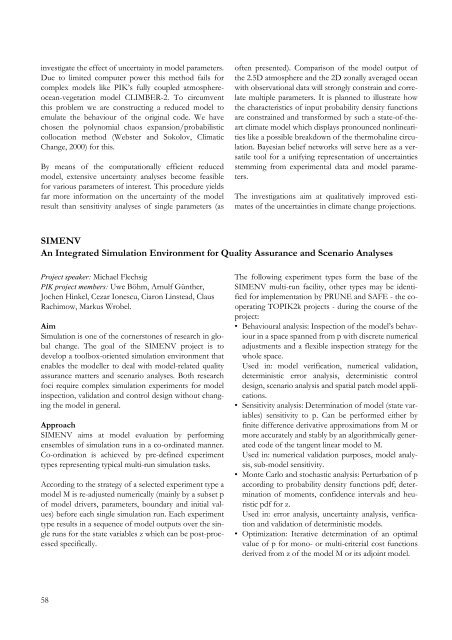PIK Biennial Report 2000-2001 - Potsdam Institute for Climate ...
PIK Biennial Report 2000-2001 - Potsdam Institute for Climate ...
PIK Biennial Report 2000-2001 - Potsdam Institute for Climate ...
You also want an ePaper? Increase the reach of your titles
YUMPU automatically turns print PDFs into web optimized ePapers that Google loves.
investigate the effect of uncertainty in model parameters.<br />
Due to limited computer power this method fails <strong>for</strong><br />
complex models like <strong>PIK</strong>’s fully coupled atmosphereocean-vegetation<br />
model CLIMBER-2. To circumvent<br />
this problem we are constructing a reduced model to<br />
emulate the behaviour of the original code. We have<br />
chosen the polynomial chaos expansion/probabilistic<br />
collocation method (Webster and Sokolov, Climatic<br />
Change, <strong>2000</strong>) <strong>for</strong> this.<br />
By means of the computationally efficient reduced<br />
model, extensive uncertainty analyses become feasible<br />
<strong>for</strong> various parameters of interest. This procedure yields<br />
far more in<strong>for</strong>mation on the uncertainty of the model<br />
result than sensitivity analyses of single parameters (as<br />
58<br />
often presented). Comparison of the model output of<br />
the 2.5D atmosphere and the 2D zonally averaged ocean<br />
with observational data will strongly constrain and correlate<br />
multiple parameters. It is planned to illustrate how<br />
the characteristics of input probability density functions<br />
are constrained and trans<strong>for</strong>med by such a state-of-theart<br />
climate model which displays pronounced nonlinearities<br />
like a possible breakdown of the thermohaline circulation.<br />
Bayesian belief networks will serve here as a versatile<br />
tool <strong>for</strong> a unifying representation of uncertainties<br />
stemming from experimental data and model parameters.<br />
The investigations aim at qualitatively improved estimates<br />
of the uncertainties in climate change projections.<br />
SIMENV<br />
An Integrated Simulation Environment <strong>for</strong> Quality Assurance and Scenario Analyses<br />
Project speaker: Michael Flechsig<br />
<strong>PIK</strong> project members: Uwe Böhm, Arnulf Günther,<br />
Jochen Hinkel, Cezar Ionescu, Ciaron Linstead, Claus<br />
Rachimow, Markus Wrobel.<br />
Aim<br />
Simulation is one of the cornerstones of research in global<br />
change. The goal of the SIMENV project is to<br />
develop a toolbox-oriented simulation environment that<br />
enables the modeller to deal with model-related quality<br />
assurance matters and scenario analyses. Both research<br />
foci require complex simulation experiments <strong>for</strong> model<br />
inspection, validation and control design without changing<br />
the model in general.<br />
Approach<br />
SIMENV aims at model evaluation by per<strong>for</strong>ming<br />
ensembles of simulation runs in a co-ordinated manner.<br />
Co-ordination is achieved by pre-defined experiment<br />
types representing typical multi-run simulation tasks.<br />
According to the strategy of a selected experiment type a<br />
model M is re-adjusted numerically (mainly by a subset p<br />
of model drivers, parameters, boundary and initial values)<br />
be<strong>for</strong>e each single simulation run. Each experiment<br />
type results in a sequence of model outputs over the single<br />
runs <strong>for</strong> the state variables z which can be post-processed<br />
specifically.<br />
The following experiment types <strong>for</strong>m the base of the<br />
SIMENV multi-run facility, other types may be identified<br />
<strong>for</strong> implementation by PRUNE and SAFE - the cooperating<br />
TO<strong>PIK</strong>2k projects - during the course of the<br />
project:<br />
• Behavioural analysis: Inspection of the model’s behaviour<br />
in a space spanned from p with discrete numerical<br />
adjustments and a flexible inspection strategy <strong>for</strong> the<br />
whole space.<br />
Used in: model verification, numerical validation,<br />
deterministic error analysis, deterministic control<br />
design, scenario analysis and spatial patch model applications.<br />
• Sensitivity analysis: Determination of model (state variables)<br />
sensitivity to p. Can be per<strong>for</strong>med either by<br />
finite difference derivative approximations from M or<br />
more accurately and stably by an algorithmically generated<br />
code of the tangent linear model to M.<br />
Used in: numerical validation purposes, model analysis,<br />
sub-model sensitivity.<br />
• Monte Carlo and stochastic analysis: Perturbation of p<br />
according to probability density functions pdf; determination<br />
of moments, confidence intervals and heuristic<br />
pdf <strong>for</strong> z.<br />
Used in: error analysis, uncertainty analysis, verification<br />
and validation of deterministic models.<br />
• Optimization: Iterative determination of an optimal<br />
value of p <strong>for</strong> mono- or multi-criterial cost functions<br />
derived from z of the model M or its adjoint model.

















